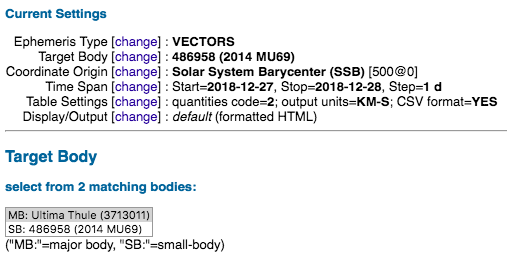Today I downloaded the state vectors for New Horizons and MU69 Arrokoth and subtracted their positions. The two new get closer than about 596,000 kilometers.
The New Horizons output header says:
Revised: Dec 29, 2018 New Horizons Spacecraft -98
and the 2014-MU69 output says:
Rec #: 486958 (+COV) Soln.date: 2015-Apr-07_15:31:42 # obs: 58 (118 days)
These suggest to me that the New Horizons state vectors should be quite accurate as they have been revised after the flyby, and that the MU69 state vectors are wrong because 118 days in 2015 is not enough data to predict the position accurately at the end of 2018.
But could it really be off by over a half-million km?
There certainly must be a better solution somewhere for MU69; was it not released to the public?
Have I simply done something wrong?
Here's a sample datapoint just for general reference
MU69:
2458479.500000000, A.D. 2018-Dec-27 00:00:00.0000, 1.798784534455549E+09, -6.207675388216038E+09, 2.205418932665184E+08, 4.349272029256285E+00, 1.451130097969201E+00, -1.243301247191951E-01,
New Horizons:
2458479.500000000, A.D. 2018-Dec-27 00:00:00.0000, 1.799376676456984E+09, -6.207654742562343E+09, 2.204740238154533E+08, 5.470499469838275E+00, -1.297281585240275E+01, 5.087368672814954E-01,




